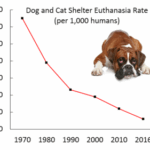Selective breeding has been a practice utilized by humans for millennia, a mechanism designed to amplify particular traits within various species. At first glance, this seemingly noble endeavor can appear benign or even beneficial. It promises enhanced productivity, aesthetic beauty, or improved performance in domesticated animals. However, an insidious reality simmers beneath the surface—a growing acknowledgment that selective breeding often culminates in profound suffering for the beings it aims to ‘improve.’ Herein lies the crux of the matter: why is selective breeding considered a form of cruelty?
To understand the ethical quandaries associated with selective breeding, one must contemplate its fundamental premise: the meticulous manipulation of genetic outcomes. Humans engage in this practice with an aim to accentuate desirable characteristics such as size, color, or even temperament. The unintended ramifications, however, frequently manifest in the form of physical deformities, chronic health issues, and severe behavioral anomalies. The underlying principle here is not merely about attaining a desirable end product but rather the harsh travails endured by the animals subjected to these genetic experiments.
The proverbial ‘picture-perfect’ canine may boast an eye-catching coat and a symmetrical physique. Nonetheless, the ramifications of selective breeding can pose serious threats to their health. Numerous dog breeds, for instance, have been artificially selected for specific traits, leading to an array of maladies. Bulldogs, celebrated for their distinctively flattened snouts, are emblematic of this issue. These creatures frequently grapple with brachycephalic obstructive airway syndrome, which endows them with breathing difficulties and can often be life-threatening. What was once perceived as a charming quirk has morphed into a cruel handicap, rendering everyday activities a struggle for animals still cherished by their owners.
Equally alarming is the phenomenon known as “cookie-cutter” breeding practices, where animals are bred primarily for looks rather than health or temperament. Such practices abound in commercial breeding operations, where profit supersedes the welfare of animals. Animals are often crammed into conditions that prioritize quantity over quality, resulting in overcrowding and a lack of proper socialization. The mental and emotional toll these animals experience can manifest as anxiety, aggression, and other problematic behaviors, debunking the fallacy that breeding for aesthetics promotes a harmonious lineage.
In the realm of livestock, selective breeding has been lauded as revolutionary, enhancing productivity in terms of milk output, weight gain, and disease resistance. However, the ethical implications of breeding animals for extreme production traits cannot be overlooked. For instance, chickens bred for rapid growth often succumb to a myriad of health complications, including metabolic disorders, skeletal diseases, and heart failure. The drive for efficiency leads to agonizing consequences, ensnaring these creatures in a cycle of pain as they are bred to grow faster than their biological systems can accommodate.
Beyond the physical suffering, there exists a deeply ingrained psychological component that warrants further examination. Animals, like humans, exhibit a range of emotions and social behaviors. The sheer isolation inherent in many breeding programs can devastate an animal’s psychological well-being. For example, breeding sows are often confined to individual gestation crates, inhibiting their natural behavior and causing immense distress. The impact of such confinement reverberates throughout their lives, engendering a chronic state of anxiety and a lifelong struggle even after they are no longer bred. Intentionally depriving an animal of its instinctual behaviors is not merely neglect; it is a calculated act of cruelty.
The ethical discourse surrounding selective breeding invokes a keener consideration of humane practices. In an era where animal welfare is increasingly prioritized, the persistence of these unethical breeding practices is disconcerting. Advocates for animal rights argue for a paradigm shift towards adopting breeding standards that prioritize genetic diversity, health, and temperament. By fostering a more holistic approach to animal husbandry, humans can mitigate the suffering ingrained in current practices and cultivate breeds that flourish without the burden of merciless genetic manipulation.
Society must grapple with the cognitive dissonance of being enamored with certain traits while blithely ignoring the resulting suffering. Public sentiment surrounding animal welfare is evolving; many consumers are advocating for transparency within breeding industries and supporting organizations prioritizing ethical treatment. The pet ownership landscape is shifting, leading to more conscientious choices regarding breed selection, with a growing preference for adopting animals from shelters rather than commercially bred sources. This progression reflects a burgeoning awareness that fosters compassion over exploitation.
In conclusion, while selective breeding may have been initially perceived as a step toward progress, a closer examination reveals that it often results in grave injustices against the very beings it aims to serve. The culmination of physical deformities, psychological agony, and ethical dilemmas underscores the necessity for a critical reevaluation of breeding practices. To truly honor the lives of animals, individuals must recognize selective breeding as a form of cruelty and advocate for practices that honor their complexity, their needs, and their right to live free of suffering. This transformative journey toward a humane approach is not merely desirable; it is an imperative for a just society.




